received 2003.10.21 from Anna Kulpa, curator of the competition, see also the Call for entries for more details
|
JURY DECLARATION
The jury of the IX International Biennale of Theatre Poster - Rzeszow 2003 consisted of: Dimitris Arvanitis (Greece), Mieczyslaw Gorowski (Poland), Holger Matthies (Germany), Peter Pocs (Hungary), Zbigniew Rybka (Poland) and Wladyslaw Serwatowski (Poland) - chairman, during the sitting on October, 9-13, 2003 in the Wanda Siemaszkowa Theatre in Rzeszow, after viewing 533 posters submitted by 160 authors from 34 countries decided to award the following prizes: The first prize to: Pierre Mendell Design Studio (Germany) for the poster "Il ritorno d'Ulisse in patria" by Claudio Monteverdi in Bayerische Staatsoper The second prize to: Miroslaw Adamczyk (Poland) for the set of posters: "Hamlet wtory" (Teatr Polski in Poznan), "Feliksy Warszawskie 2001 - Warsaw Theatrical Annual Awards" (Teatr Powszechny in Warsaw), "Feliksy 2002 - Warsaw Theatrical Annual Awards" (Teatr Polski in Warsaw) and "The Shape of Things" by Neil LaBute (Teatr Powszechny in Warsaw) The third prize to: Lex Drewinski (Germany/Poland) for the poster "Die Emigranten" by Slawomir Mrozek in Strassentheater Berlin Jury declared very high level of the posters in Biennale contest and awarded six equal honorary mentions to: Freeman Lau, Rebecca Yip (Hong Kong) for "Good Wind Like Water" (Theatre Hong Kong City Hall)
The jury's decision is final and irrevocable. Rzeszow, 2003.10.12. |
Here are some of the winning posters:
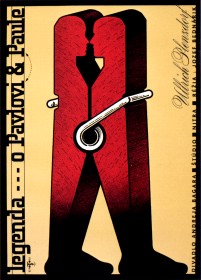
Vladislav Rostoka "The legend of Paul and Paula" |
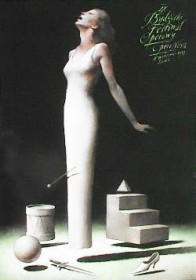
Wieslaw Walkuski "9th Opera Festival" (Opera Nova in Bydgoszcz) |
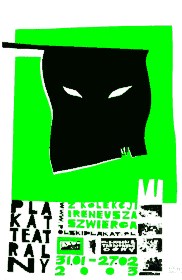
Monika Starowicz "Plakat teatralny, kol. Swierc" |
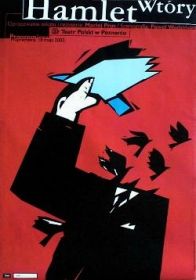
Miroslaw Adamczyk "Hamlet 2" |
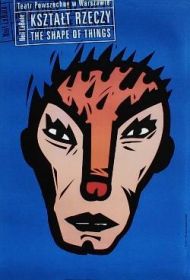
Miroslaw Adamczyk "The Shape of Things" |
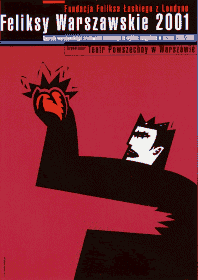
Miroslaw Adamczyk "Feliksy Warszawskie 2001" |
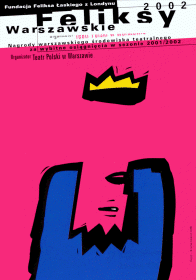
Miroslaw Adamczyk "Feliksy Warszawskie 2002" |
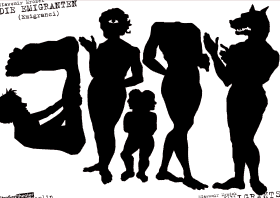
Lex Drewinski "Die Emigranten" by Slawomir Mrozek |
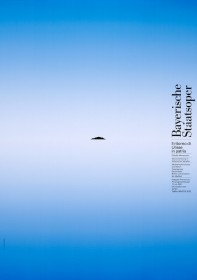
Pierre Mendell Design Studio "Il ritorno d'Ulisse in patria" by Claudio Monteverdi |
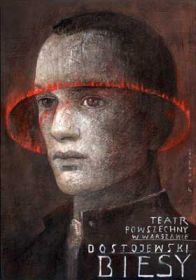
Wiktor Sadowski "The Devils" by Fiodor Dostojewski |
|
THEATER POSTERS IN COMPETITION 2003
There are five phenomena that fixed in my memory the discussions of the jury of the 9th International Biennale of Theatre Poster in Rzeszow, which took place in October 2003.
Ad 1. Distinct disproportion between posters sent by authors and publishers came into view in this year’s edition. It turned out that theaters often submitted their authors’ works to manifest that they issue posters and to show the repertoire of plays performed sometime on their stages. Having a friendly attitude towards the Rzeszow Biennale, theaters occasionally failed to meet formal requirements and submitted formats of visual advertisement which did not meet the biennale’s regulations defining poster. Situations when the fact of sending posters to partake in the competition was not consulted with their author also took place. The organizers of the Biennale accepted posters from two sources - the author and theatre. However, they will endeavor to modify the regulations for the 10th jubilee IBTP in 2005 in such a way as to exclude the situation in which granting an award to a poster artist becomes a surprise to the author himself/herself, as he or she did not submit their posters to the competition. Ad. 2. A threat to poster lies in cluttering the essential composition with seemingly necessary marks of the institutions supporting a theatre or a play. Weak are those theatre art directors who can not reserve the final decision for themselves, allowing them to restrict the number and size of sponsors’ marks in such a way as to ensure that they are in harmony with the composition. I have the impression that sponsors’ marks are often added after the poster has been designed and are placed in purely accidental places. Only few theatres can duly appropriate space for those marks and comply with the rule of placing the acquired logotypes in designated places and in strictly defined sizes. Ad 3. In March 1985 I saw a poster with a white and red "P" on black background. Its title was "Polnische Plakat" and it announced the Polish poster exhibition at the Munich Municipal Museum. The author of this succinct, geometrical composition presenting a rectangle, a semicircle and a cylinder, was the then 56 old Pierre Mendell working in Munich. I have been observing the work by Mendell, this year’s first prize winner in Rzeszow, for 18 years now. I admire in Mendell the clarity and order of his posters for the Munich Opera, which he designs as a perfect stylist - one controlling emotions and eliminating redundant elements. I do not share the opinion about Mendell’s posters that they exemplify the notion of art for art’s sake. His posters, through their elegance and style, remind of the author himself; one who loves life with its simplicity but creates elevated art of the highest level. This takes place independent of whether the designs concern authors’ exhibitions, thematic exhibitions, social slogans, public trust institutions or opera and theatre performances. The graphic economy of Pierre Mendell’s works is thought-provoking, inviting to an intellectual dialogue. Everyone will find in his poster something unusual and surprising. His best known posters are "Church and Art", "Macbeth", "A Wedding Announcement", "Paper for Lovers". After the 10th IBTP Rzeszow 2003 the finest compositions by Mendell have been enriched by "Ulysses’ Return to His Homeland" of which editors of the Bavarian Opera should be proud. They submitted a true gem to partake in the competition; one whose beauty magically connected the jurors. Ad 4. The term "the Polish school of poster," introduced to professional literature by Jan Lenica, is still enjoying its international success. Polish poster owes its excellent condition to theatres which, though often overcoming financial problems, still commission posters from great masters and their successors. Looking at the works by Adamczyk, Drewinski, Starowicz, Majewskiego, Sadowski, Walkuski, Grzegorczyk and Zebrowski as well as by Starowieyski, Swierzy, Kalarus and Pagowski, submitted to the 10th IBTP Rzeszow ‘2003, I am inclined to express my belief in the renaissance of Polish theatre poster which overwhelms the crisis visible in Polish movie poster. The respect and admiration shown by the foreign jurors: Dimitris Arvanitis, Holger Matthies and Peter Pocs towards the exhibition of works by Franciszek Starowieyski at BWA in Rzeszow and towards the designing artistry of the earlier posters by Henryk Tomaszewski, Jan Mlodozeniec, Jan Lenica, Roman Cieslewicz and Maciej Urbaniec had nothing to do with conventionality or politeness. Polish artists-designers incessantly treat us with a free-of-charge poster school of works of art glued onto the litfasses in the streets (a round bill-post; the name created after Ernst Litfass, 1816-1874). Ad 5. It has been 25 years since the competition announced by "The Collector," a supplement to "The Polish Courier," took place and since the neologism “plakacjoner" (posters collector) was introduced to the Polish language by an English graduate Marta Latoszkowna. In this way a posters collector, a hobbyist, an admirer and, as is often the case, a poster art animator were described in one word. Ireneusz Szwierc, a “plakacjoner" from Zabrze who majored in German, prepared out of his own collection a theatre posters exhibition for "A Different Sileasia" gallery in Tarnowskie Gory. A poster introducing to this display, printed as serigraphics in one hundred copies, was designed by Monika Starowicz, who graduated from the Fine Arts Academy in Katowice in 2000 and is nowadays an assistant to Professor Roman Kalarus at the same Academy. It was a historic moment as it was the first time that the jury of the Biennale in Rzeszow had granted an award to a poster about theatre poster exhibition. Starowicz and Szwierc made the debut in their domains in the 21st century. It is a great and successful debut when one is granted an award at an international competition in which 530 posters competed. I congratulate Monika Starowicz and Ireneusz Szwierc and wish them both that this award becomes a stimulus for their creative work and a motivation for strengthening the fame of Polish theatre poster. From the above impressions I may conclude that theatre poster around the world harmoniously inserts itself into the phenomenon known as globalization. It originates in different places. It connects theatres, audiences and poster admirers. Great metropolises with many theatres, such as Munich, Hong-kong, or Berlin, compete with cities far smaller but nonetheless strong due to the talent of their artists; among the latter, one may find such cities as Nitra, Rzeszow and Tarnowskie Gory. The metropolises do not have the warrant or exclusiveness for success. Theatre posters commissioned for Paris, New York, London, Moscow, Rome, Teheran and Istanbul did not induce the jurors of the Rzeszow Biennale ‘2003 to their compositions, rooted in the visual tradition of the place they originated in. Along with the formerly awarded artists (Majewski, Sadowski, Walkuski), also the partners and colleagues of previous prize-winners send their works to the Rzeszow Biennale. After Kan Tai-keung from Hong-kong, who received an award at the Rzeszow Computer Art Biennale, this year’s winner is Freeman Lau (1958-) from Design & Associates Ltd. Most probably he owes this award to the beautifully composed photograph of Rebecca Yip’s figure, who as a well-known woman organization activist was put on the poster of a musical performance "Wind Good as Water". Vladyslav Rostoka (1948-), a graduate of the Academy in Bratislava, is a prominent Slovak graphic-designer. He designs posters and closely cooperates with the International Poster Trnava Triennial. Hopefully, the award granted him, as well as his visit to Rzeszow, will bring about closer contacts between Rzeszow and Trnava, allowing exchanges of international poster collections. Wladyslaw Serwatowski |
home more winners page created on October 22, 2003 / this section is part of Rene Wanner's Poster Page /